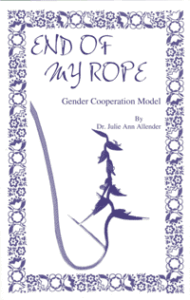
END OF MY ROPE:
Gender Cooperation Model
Copyright 1996 by Julie Ann Allender, Ed.D.
149 pages, soft cover
End of My Rope is a book about everyone in the world now. It describes every gender, generation, race, culture and nationality. Gender Cooperation Model is a concept developed based on the reality that the world is changing and has changed. It explores the movement away from what most of us call the traditional model in which mom was homemaker and dad was a breadwinner to the newer model in which both women and men share a more equal role.
The book explores struggles, difficulties and pitfalls in attempting to leave the old traditions behind. It also looks at some of the historical perspective in relationship to Elizabeth Kubler-Ross’s stages of death and dying.
The purpose of the book is to bring increased awareness to individuals struggling to learn how to cope in this ever-changing world and to increase the skills necessary for survival.
The goal is for each of us to add to this model and eventually come up with one that works. The other end product of this book will be to discover that it is not one model alone but possibly many. When one reaches the end of one’s rope, one must look back at the beginning and figure out where one got hung up, put a flower on the end of the rope, water it, nurture it and help it grow. Only then will we truly find success from the frustrations, hurt, sadness, anger, happiness and other feelings that we experience in this frustrating process of creating a new model.
Chronic Illness – Healing the Wounded Heart
Copyright 1999 by Julie Ann Allender, Ed.D.
120 pages, soft cover
Chronic Illness – Healing the Wounded Heart
Price (Includes Free Shipping + Tax in PA)
Chronic Illness: Healing the Wounded Heart is the second edition of my first book End of My Rope: Gender Cooperation Model. The first book was written 10 years ago and was my beginning processing about the model that I use in working with people of all ages. Chronic Illness is my second book rewritten 10 years later with all newer information and newer learning’s. It is a book that not only shows my growth and changes, but also the growth and changes that I have shared and learned in working with people of all ages in the ever changing world in which only 11% of traditional relationships remain.
Chronic Illness gives a much more in depth outlook. It gives newer and different ways to explore the problems and to create even more exciting and successful change in order to equalize relationships and end up with happier unions, families and friends.
The one big difference in the two books is that the second one, Chronic Illness is written for not just all men, women and children. It is also written for those who are chronically ill and have the additional struggles of illness to deal with when trying to implement the modeling changes of gender cooperation. This book gives insights as well as empathy and understanding to individuals who struggle every day not only with relationships and trying to achieve a balance, but also to the additional difficulties that are encountered in those who are chronically ill. The additional stressors, tiredness and pain that are in addition to the normal stressors.
It was easy to write this book because everyone in my immediate family suffers from a serious chronic illness. The illness, not alone, but was also a major contributor to my husband and I getting divorced. This book was truly written from the heart with a great deal of compassion and understanding of the real issues of people trying to achieve equality, happiness and what each feels is fair and deserved. Traditional relationships are gone and replacing them with a new model is our challenge.

